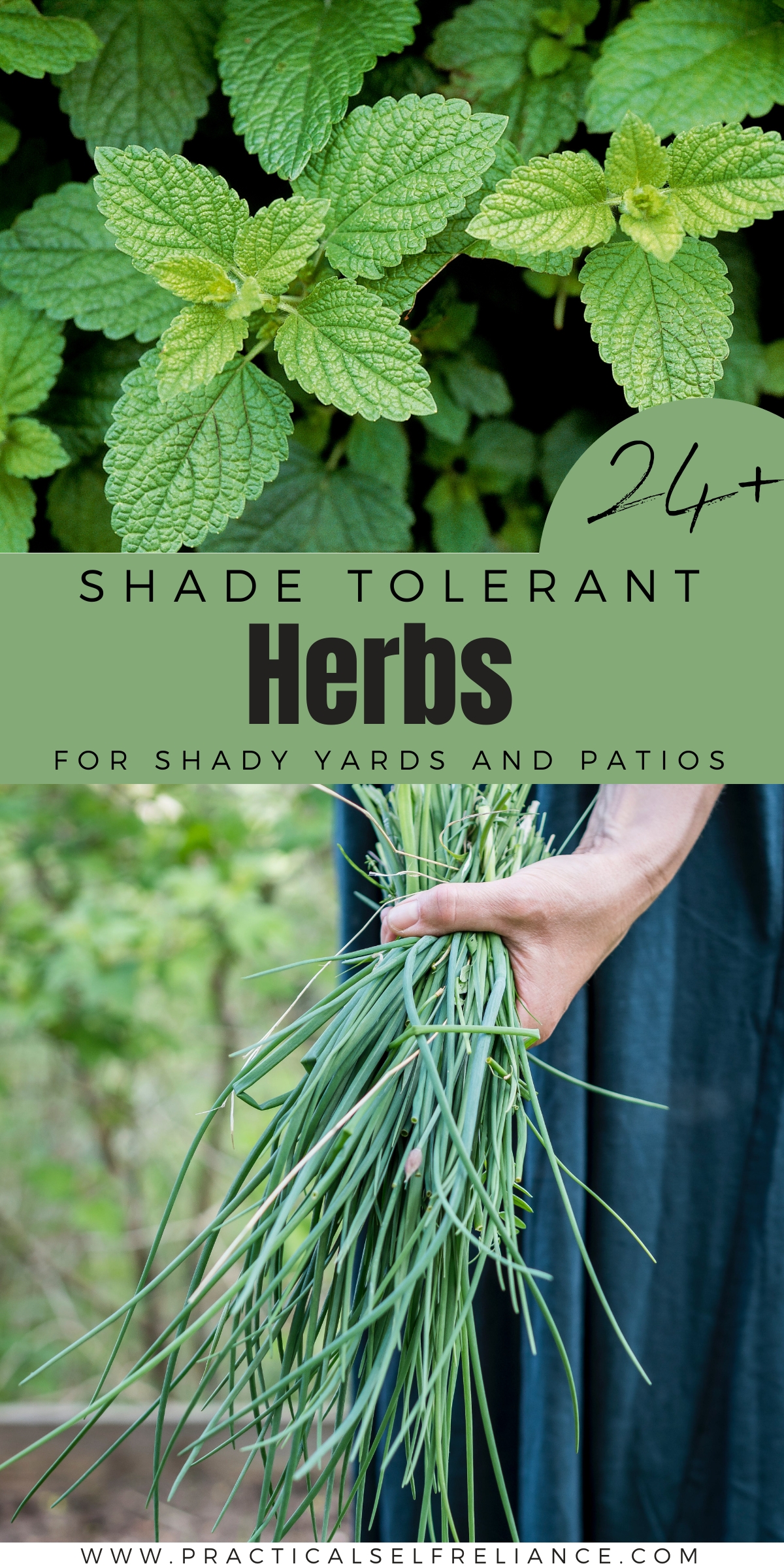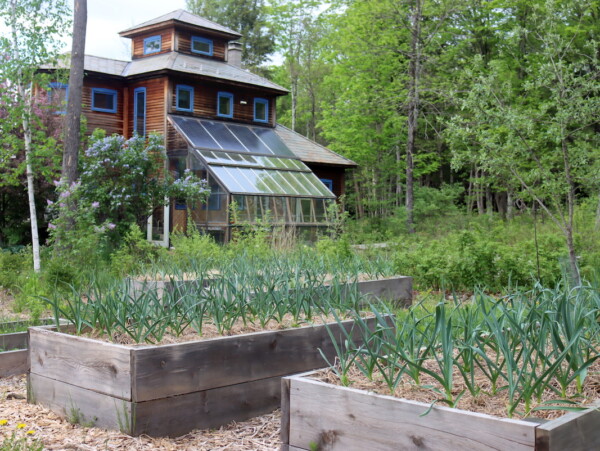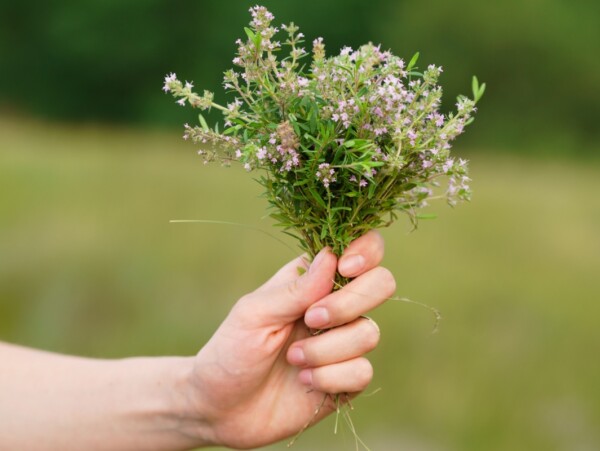Affiliate disclosure: This post may contain affiliate links. Please see our Privacy Policy.
Shade-tolerant herbs allow you to make use of parts of the yard where most veggies just won’t grow. A shady herb garden right in your dooryard makes for tasty meals, and all you have to do is pop outside to snip a few fresh herbs at dinner time.
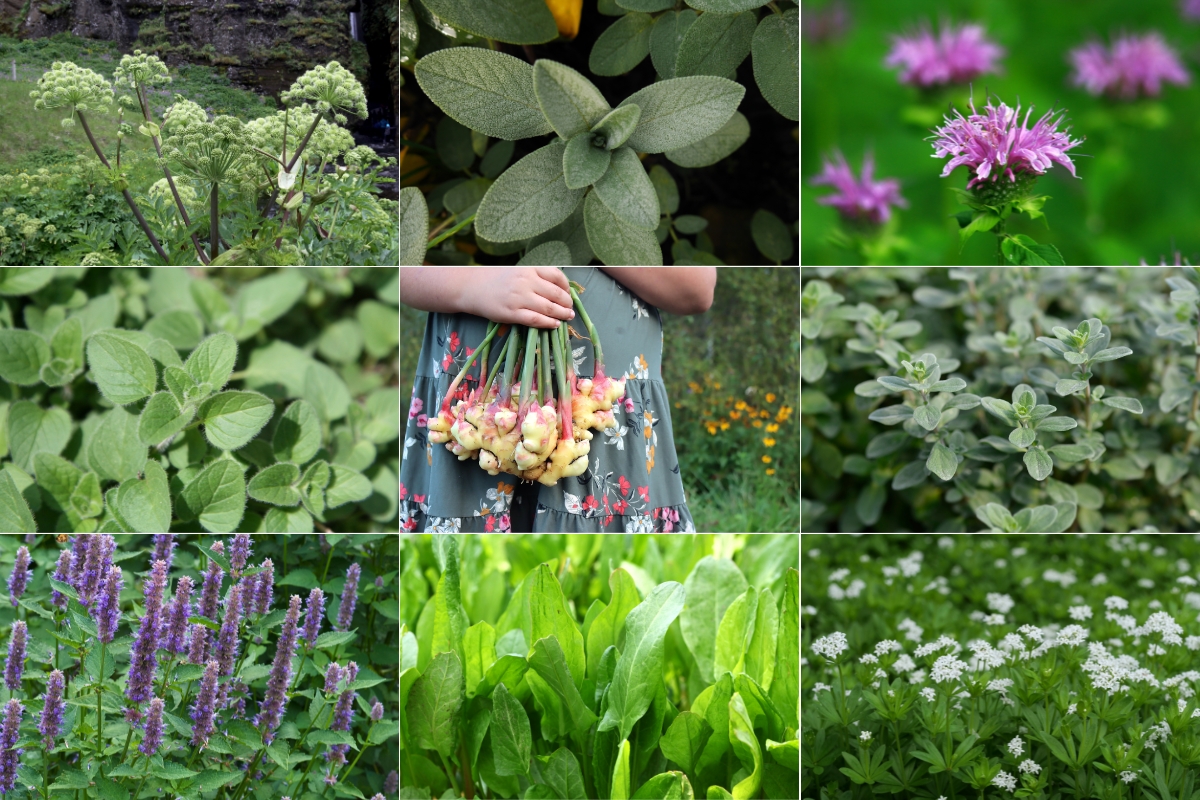
While most vegetables we grow in our gardens require full sun to produce well, herbs are much more tolerant. Certain herbs, like the heat-loving basil, thrive in full sun, others have adapted to cooler, moister areas. Some of these herbs are annual, meaning you will need to start them from seed each year, while others are perennial and will pop up each year in spring.
It may seem like you lost out if you have a shady property, but you can still have a productive garden. Partial shade is excellent for herbs that thrive in cool, moist climates or those that evolved in open woodlands and forest edges. Many of these species actually benefit from relief from the afternoon sun, especially in warmer climates.
I always include culinary herbs in our garden and suggest others do the same because it can be so pricey to get fresh or even good-quality dried herbs from the store. Having access to herbs can help you create delicious meals. They offer so much flavor in such a small package!
Perennial herbs are my favorites because they return year after year and offer tons of production with little effort. Still, most annual herbs are easy to grow, too. Some people buy transplants, but I find they’re generally easy and more affordable to start from seed. You can direct seed them in the garden or start them indoors for extra early harvests.
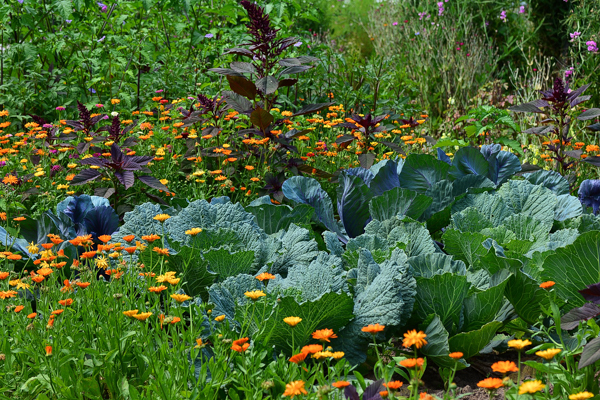
Herbs That Grow in Shade
Growing medicinal forest herb species is one thing, but what culinary herbs can you really grow in a shady garden?
While not all herbs thrive in shady gardens, there are some great options. Here’s a list of shade-tolerant culinary herbs:
- Angelica (Angelica spp.)
- Anise Hyssop (Agastache foeniculum)
- Bee Balm (Monarda spp.)
- Calendula (Calendula spp.)
- Catnip (Nepeta cataria)
- Chervil (Anthriscus cerefolium)
- Chives (Allium schoenoprasum)
- Cilantro/Coriander (Coriandrum sativum)
- Dill (Anethum graveolens)
- Ginger (Zingiber officinale)
- Lemon Balm (Melissa officinalis)
- Loveage (Levisticum officinale)
- Majoram (Origanum majorana)
- Mint (Mentha spp.)
- Oregano (Origanum vulgare)
- Parsley (Petroselinum crispum)
- Rosemary (Salvia rosmarinus)
- Sage (Salvia officinalis)
- Sorrel (Rumex acetosa)
- Sweet Cicely (Myrrhis odorata)
- Sweet Woodruff (Galium odoratum)
- Tarragon (Artemisia dracunculus)
- Thyme (Thymus spp.)
- Winter Savory (Satureja montana)
Now I’ll take you through them one by one.
Angelica (Angelica spp.)
Angelica is one of my favorite lesser-known herbs. It has fallen out of popularity, which is a real shame. Its roots, leaves, seeds, and young stems are all edible and have a wonderful, sweet licorice-like flavor. It’s a delightful flavoring for desserts and liquors, and the leaves can also be used in salads.
I also grow it for its beauty. Angelica reaches 3 to 7 feet tall, even in partial shade. Its tall purple stems feature graceful compound leaves and beautiful umbels of tiny white or greenish flowers.
You can start Angelica from seed; your plants will last a few years. It’s usually a short-lived perennial or robust biennial. Look for a spot with partial shade to full sun and rich, well-drained soil.
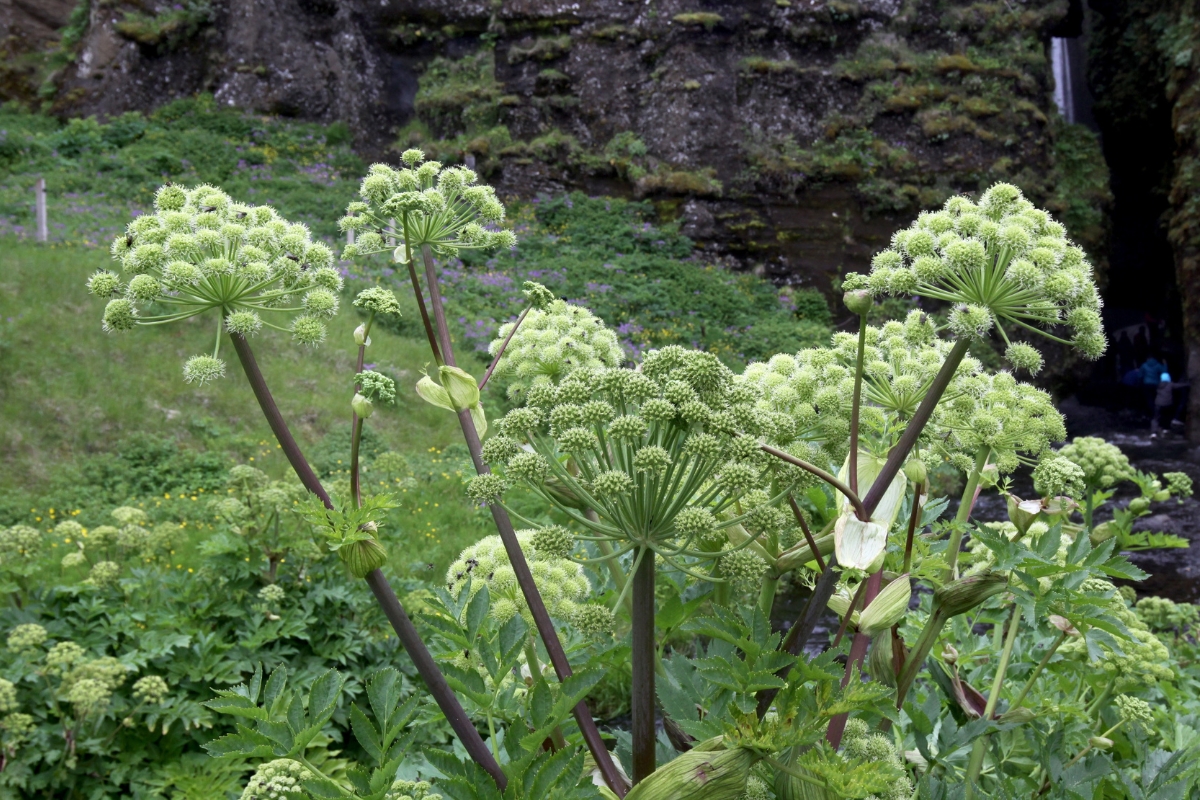
Anise Hyssop (Agastache foeniculum)
Anise Hyssop is a beautiful native herb with spikes of pretty purple flowers that attract bees, hummingbirds, and butterflies to your garden. While It primarily has a reputation as a medicinal herb, I enjoy using it in cooking, too. Its unique flavor, like a cross between mint, anise, and licorice, is well-suited to sweet dishes like cupcakes, mousse, fruit salad, iced tea, and cocktails. Surprisingly, it also makes an excellent addition to rice dishes, gazpacho, and vinaigrettes.
Once started, anise hyssop is easy to grow, but its seeds need to be stratified, making it slightly more challenging to start from seed. Getting a division from a friend, nursery, or gardening group is a great alternative. It will grow well in partial shade and tolerate a range of soil conditions as long as it is well-drained.
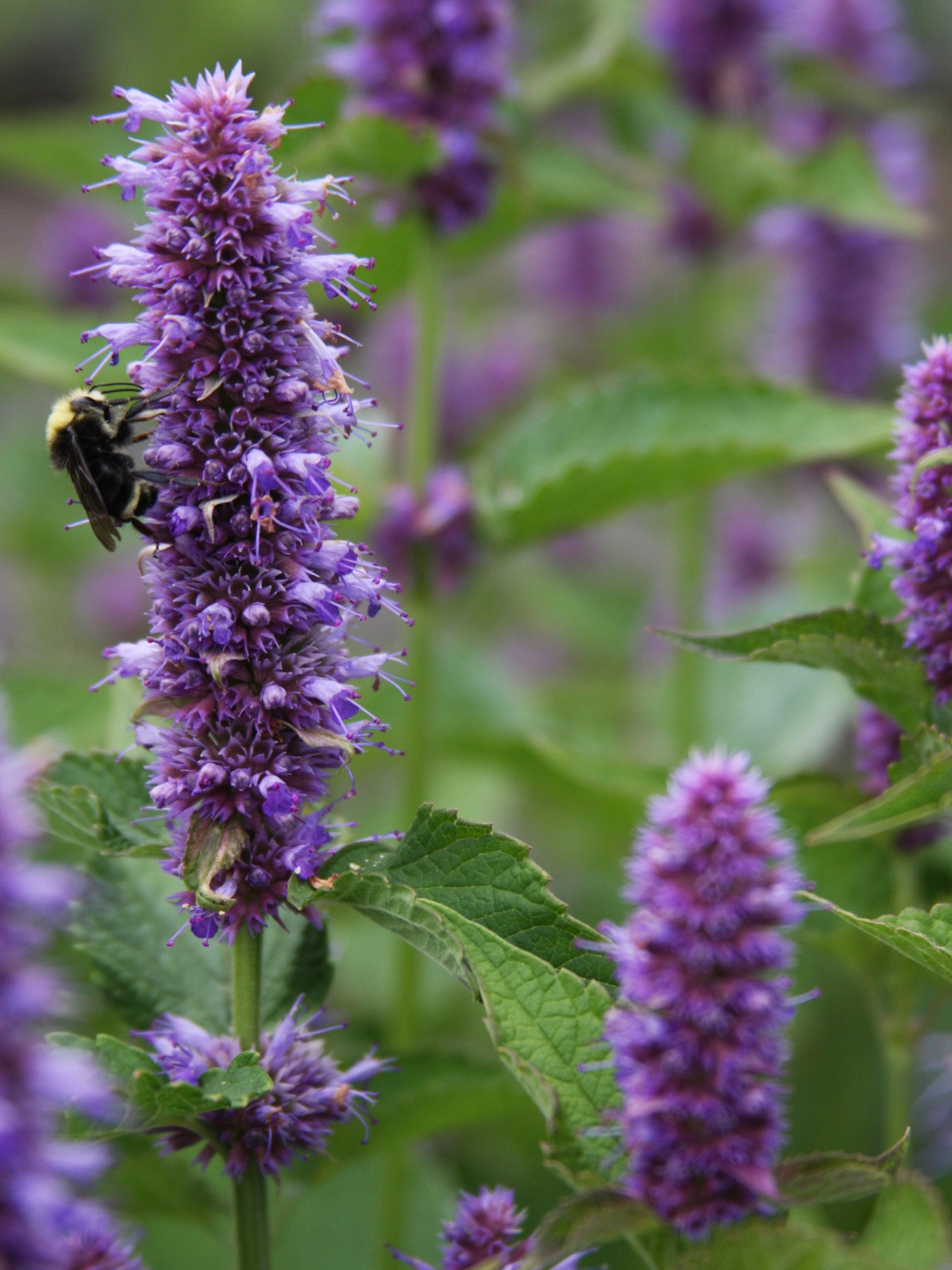
Bee Balm (Monarda spp.)
Bee Balm is one of my favorite native flowers. There are several varieties, each offering different flavors and colors. Native to the Appalachians, Lemon Bergamot (Monarda citradora) is one of my favorites with its lemony scent, slightly citrusy flavor, and pink to lavender blossoms. Wild Bergamot (Monarda fistulosa) has similar blossoms but a spicier flavor similar to Greek oregano. In contrast, Scarlet Bergamot (Monarda didyma) has bright red flowers and a pungent, savory flavor.
In total, there are 20 Monarda species, all native to North America.
Folks often include these beautiful herbs in tea for their unique flavor and medicinal benefits. While it’s less common now, they were once often used to flavor savory dishes like meat. Lemon Bergamot, in particular, makes an excellent herb for seasoning fish.
Depending on the species and cultivar, bergamot is often a hardy perennial in zones 3 through 9. Monarda will grow in partial shade to full sun but may flower a bit less in partial shade. It thrives in rich, loamy soil but will tolerate various soil types. Wild Bergamot tends to be more forgiving of dry soil and less-than-ideal conditions than Scarlet Bergamot.
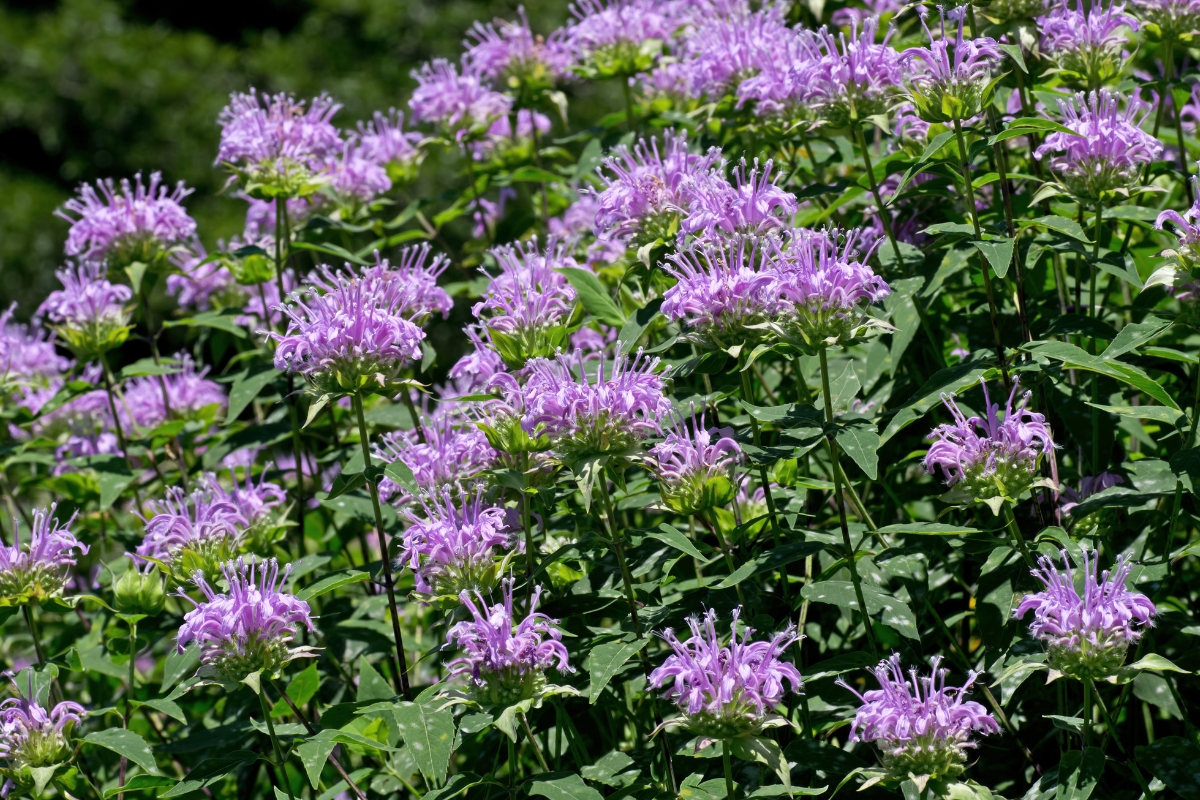
Calendula (Calendula spp.)
Herbalists are likely familiar with this sunny flower as a potent herb for skin and wound care. It gets less attention in the kitchen, but it holds its own among some of my favorite herbs. Those bright petals make an excellent natural food dye and a cheap, easy-to-grow saffron substitute for some of my favorite dishes, like chicken and yellow rice.
Calendula thrives in cool, moist soil and partial shade, especially in warm climates like the southern United States, where it needs protection from the summer heat. It’s tolerant of a wide range of soil types, including clay, and can be grown in pots.
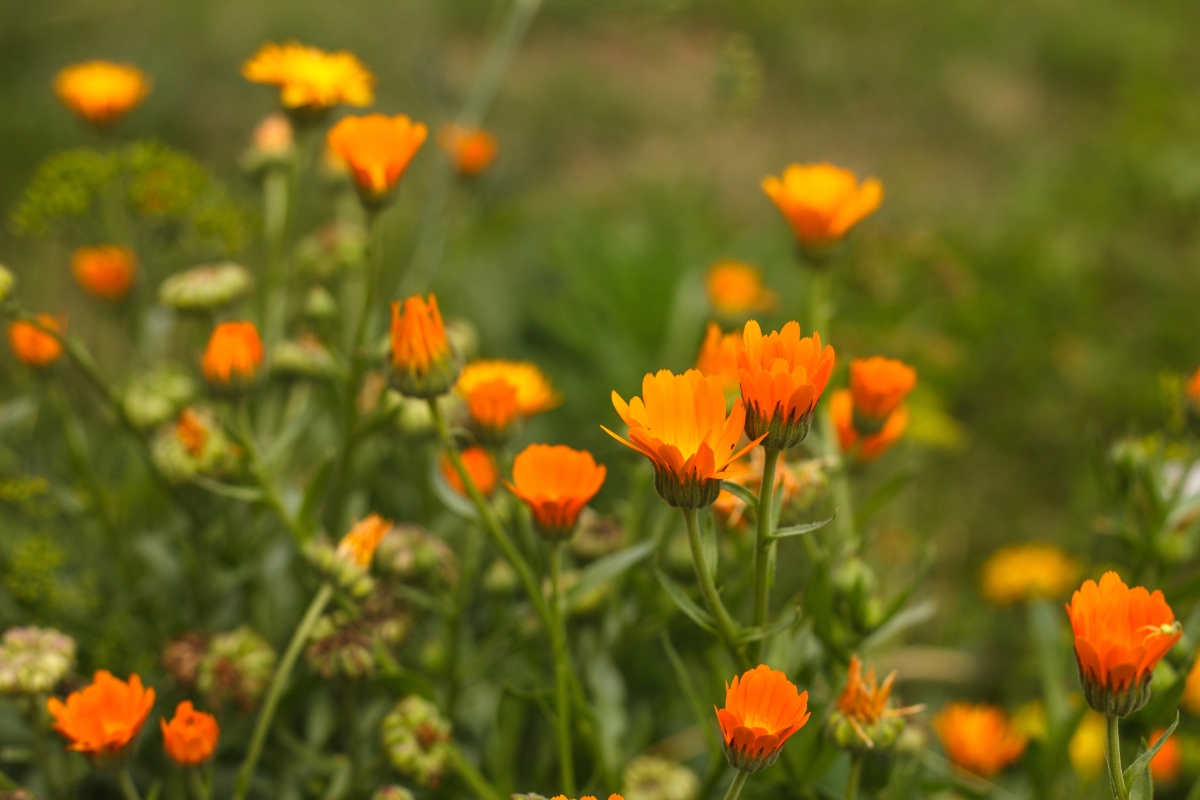
Catnip (Nepeta cataria)
No, this one isn’t just for the cats! However, if you have some feline friends, they may be enthusiastic about it growing in your shady garden, too. I like to use catnip in tea, salads, flavored butter, and seasoning blends. It has a slightly bitter, woodsy flavor. On its own, I’ve found that its taste isn’t particularly overpowering or delicious, but I love adding it to food because it aids in digestion.
Catnip is a hardy perennial that will thrive and spread in various conditions. Once you get it started, you’ll have plenty. Though not overly aggressive, this member of the mint family is perfectly capable of spreading on its own through seed and underground roots.
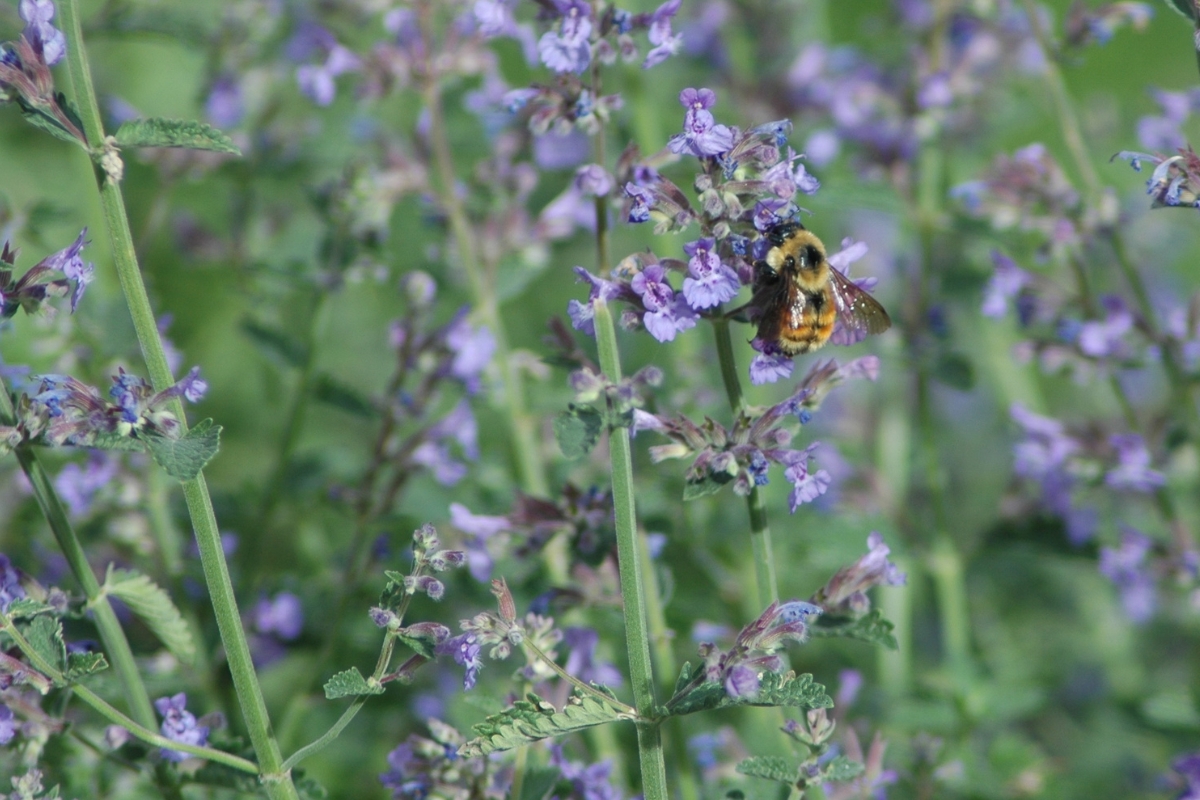
Chervil (Anthriscus cerefolium)
Sometimes called French parsley or garden chervil, this delicate-looking annual herb is related to parsley. It looks very similar to parsley with tripinnate, curly leaves, and umbels of small white flowers. It’s a mainstay of French cuisine and is part of the French herb mixture fines herbes. It’s a popular ingredient in omelets, soups, salads, and sauces.
Chervil is one of the herbs best suited to shade. In fact, it can be difficult to grow in sunny spots, especially in hot climates. In sunny areas, it tends to bolt and go to seed like lettuce. It thrives in moist, fertile, well-drained soil.
Chervil forms taproots, so it’s generally best to direct sow it in the spring. You can continue sowing until late summer for multiple harvests. Plant chervil in dense patches to recude weed pressure and prevent soil from splashing up on the leaves during rains.
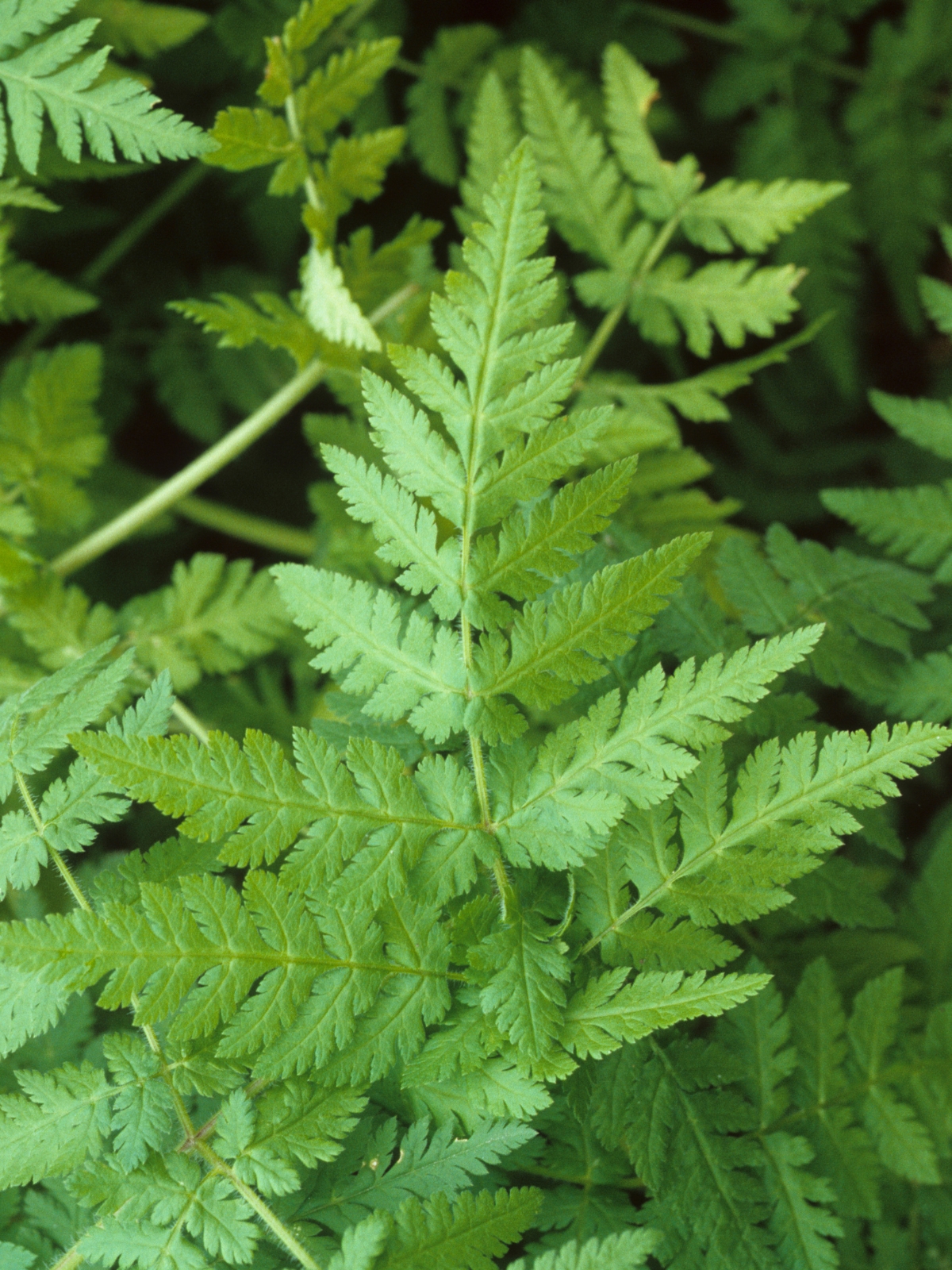
Chives (Allium schoenoprasum)
Chives are one of the herbs that exude charm. They look at home in herb gardens, cottage gardens, and even landscaped yards in suburban areas. Their oniony-flavored leaves look a bit like ornamental grass and are topped with cheerful, purple, globe-shaped flowers.
Chives are also easy keepers and do well in partial shade. Like most of these herbs, they do best in moist, well-drained soil. You can grow them for seed, purchase transplants, or get a division from a friend. Once you have them started, it’s easy to split clumps and start new plants.
I love the flavor of chives; they are so easy to use. They are my favorite for herbal butters and cheeses, and they’re easy to cut up and top soups, salads, and other dishes. You can also soak their blossoms and leaves in vinegar to create dressing.
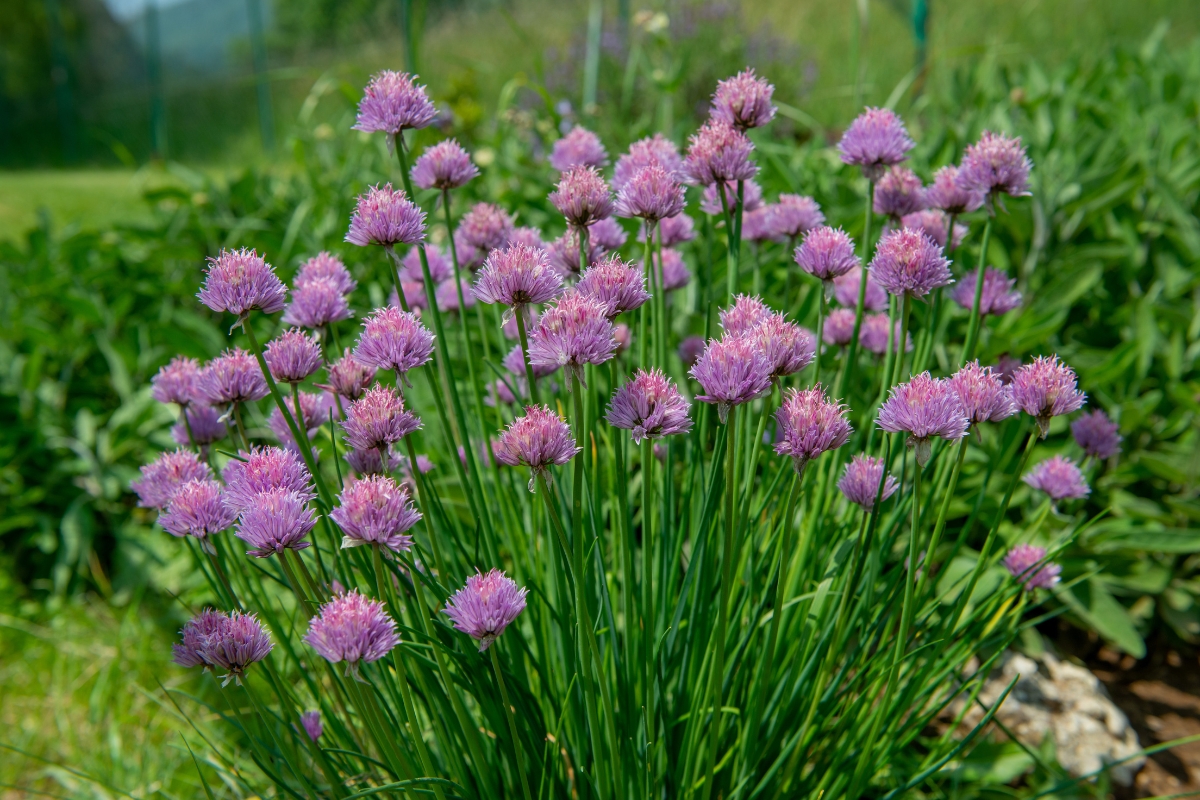
Cilantro/Coriander (Coriandrum sativum)
This herb is cilantro and coriander. If you’ve only seen these on the spice rack, you may have thought that these were two different plants. In reality, they’re the same. People use the name cilantro to refer to leaves and stems, while they refer to the seeds as coriander.
Cilantro leaves are common ingredients in salads, guacamole, salsa, and as a garnish for meat and fish. While I find cilantro enjoyable, it depends on your genes. You may find cilantro has a lemony or soapy flavor. Coriander seeds are common ingredients in chili, sausage, and even some beer. They have a different flavor than the leaves but are still lemony.
Plant your cilantro seeds in early spring. It’s a cool-season annual that thrives in moist, well-drained soil. Cilantro loves getting afternoon shade, especially in warmer climates.
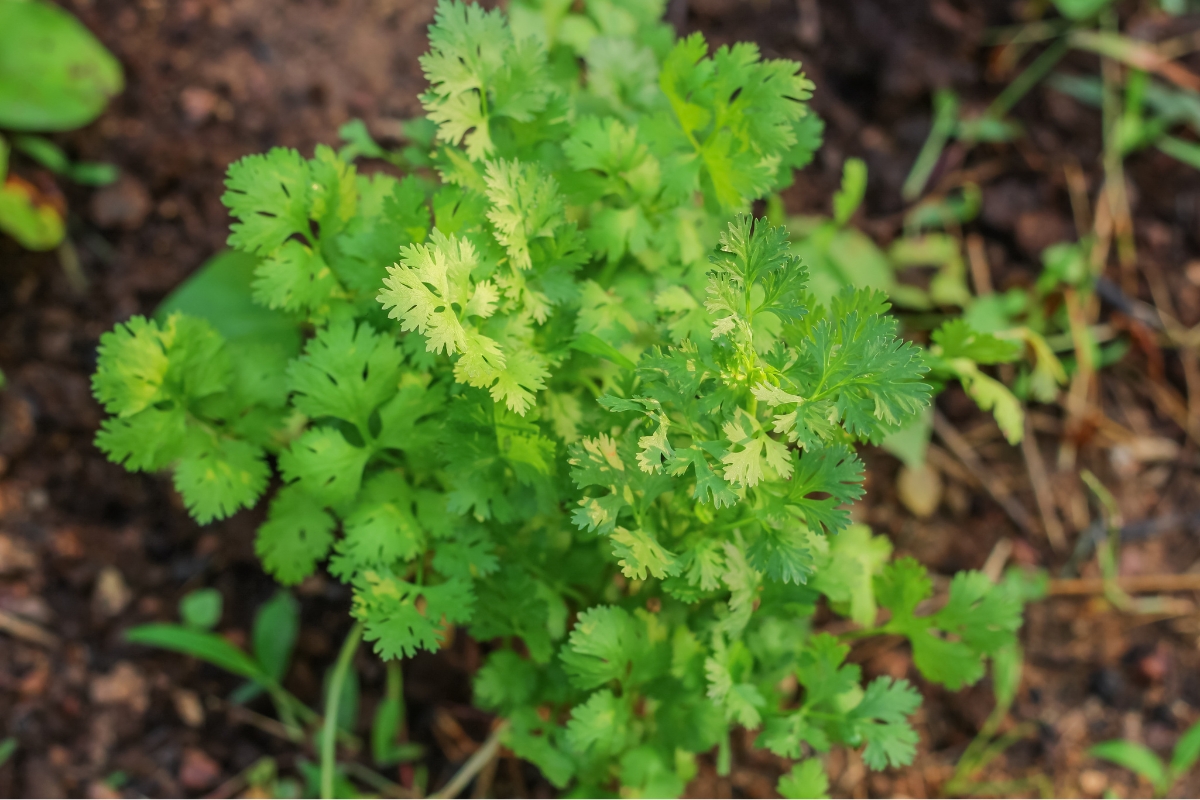
Dill (Anethum graveolens)
Dill’s use dates back to 3000 B.C.! It’s an annual culinary and medicinal herb that looks great in a flower bed, too. Its lacy leaves and umbels of tiny yellow flowers on tall stalks provide a great backdrop for flower beds.
If you ferment or can pickles, fresh dill is a must. It’s also excellent in egg, potato, fish, and chicken dishes, and you can generally expect to harvest leaves over a long period.
Dill prefers at least 6 to 8 hours of sun but will tolerate partial shade, particularly in warm climates. It’s easy to grow and should be directl sown; it doesn’t transplant easily. You may have to share a few of the leaves—they’re a favorite of black swallowtail butterfly caterpillars! The blooms attract various pollinators and beneficial insects, like parasitic wasps that feed on other garden predators.
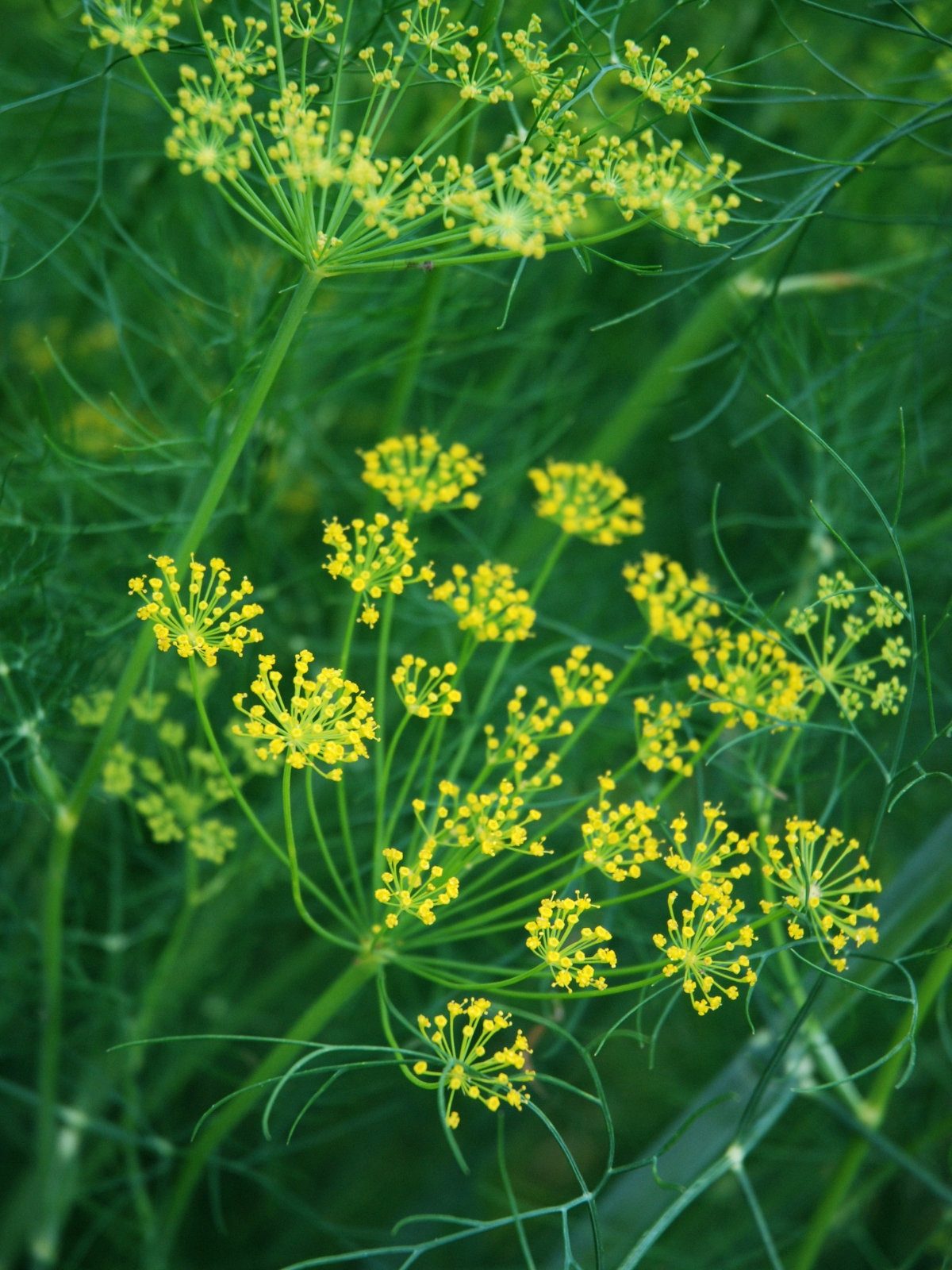
Ginger (Zingiber officinale)
Few herbs provide such pungent flavor and warmth as ginger. In the United States, ginger is often synonymous with fall and winter. It plays a major role in flavoring comforting seasonal dishes like pumpkin pie, gingerbread cookies, and apple crisps. I also love using it for fermentation, like homemade ginger beer.
Around the world, it sees more daily use in rich, flavorful dishes like curry, stir-fries, and soups.
Medicinally, it’s one of the best herbs for quickly settling upset stomachs and heartburn. It’s also known for its anti-inflammatory properties.
In cool climates, ginger can handle full sun, but in warmer climates, it must be grown in partial shade. Ginger is only perennial in zones 8 through 10. However, you can grow it as an annual in northern zones. You can also grow it in a pot and start it indoors to offer it a longer growing season.
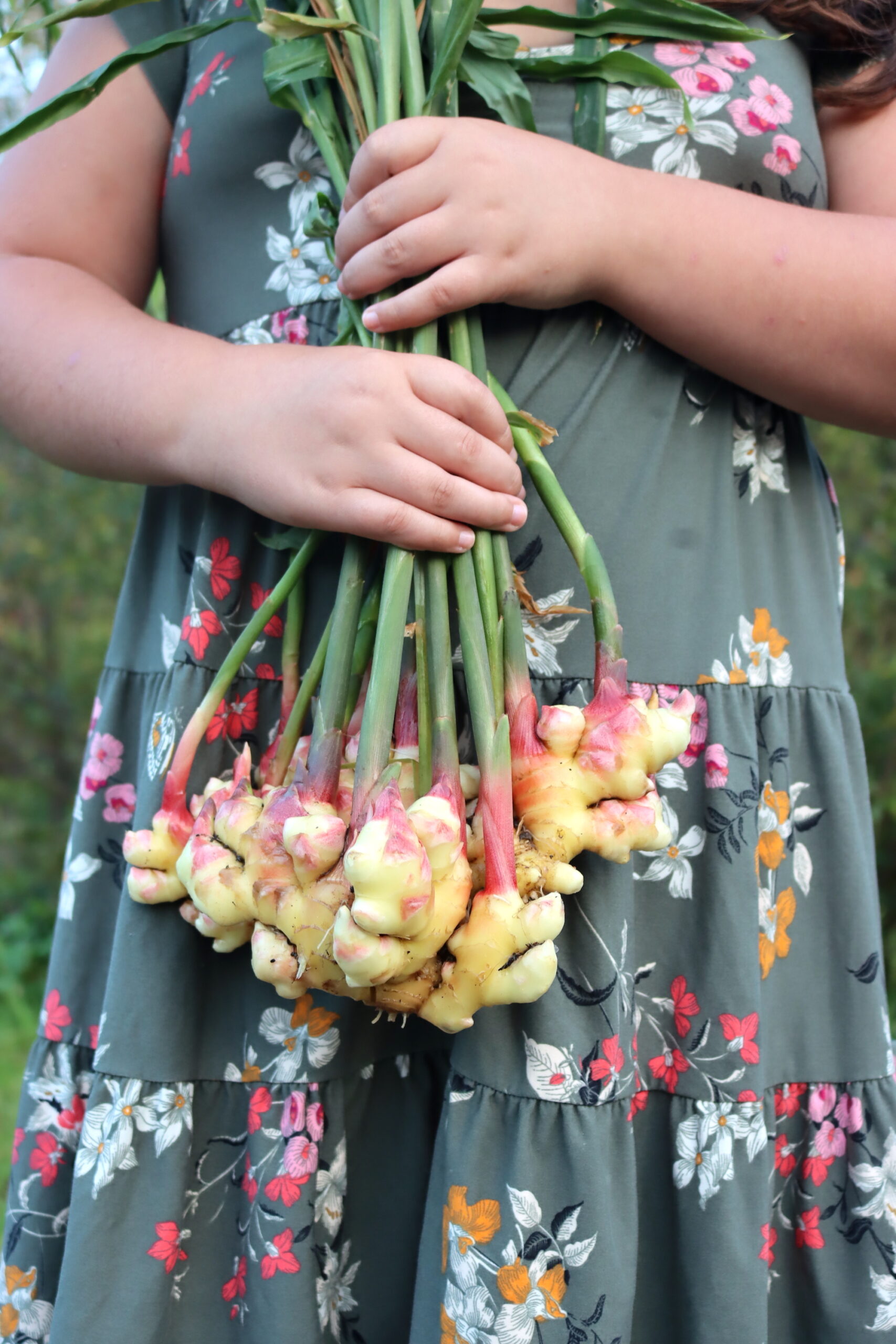
Lemon Balm (Melissa officinalis)
Brush a lemon balm plant, and you will recognize it immediately. It looks a lot like other members of the mint family, but its bright, citrusy fragrance is a dead giveaway. Lemon balm is best known as a tea herb, but it also brings a delightful mild flavor to baked goods, pasta dishes, and pesto.
Lemon balm is easy to grow in sun or shade. It needs plenty of moisture as it gets established but is quite drought-tolerant and an easy keeper once it gets going. Though not as aggressive as some, as a member of the mint family, lemon balm does plenty of wandering. I have found it easy to keep in check, but it does tend to spread, and new patches will crop up from seed.
Additionally, lemon balm is a friend to pollinators and songbirds like goldfinches, which enjoy the plant’s tiny seeds. Historically, beekeepers often planted lemon balm as they believed the bees would never leave if it was grown nearby.
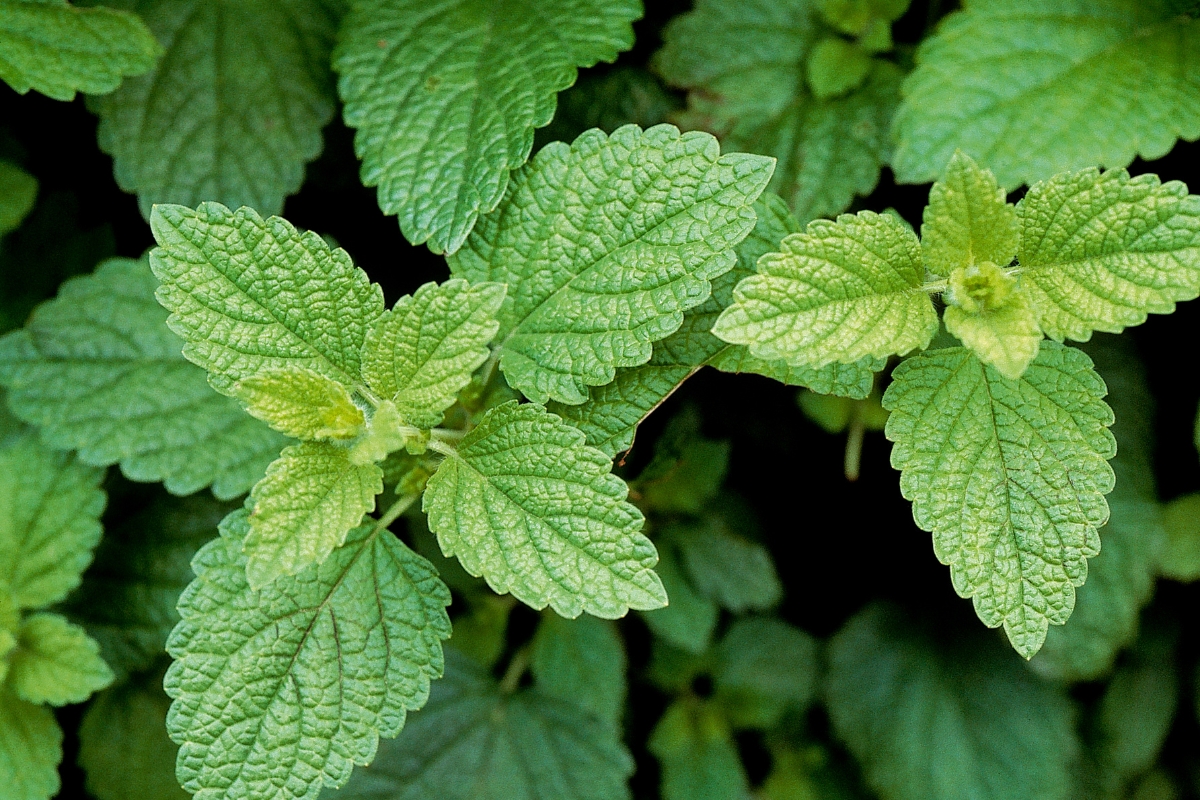
Loveage (Levisticum officinale)
This tall perennial herb was once a staple in southern European cuisine. Its roots can be used as a vegetable, and its stalks, leaves, and seeds impart a celery-like flavor to salads, soup, poultry, and pork dishes. I find its flavor quite strong, so start with a small amount if you’re new to loveage.
One of the reasons lovage was so popular is that it is a hardy, robust perennial. Once established, lovage requires very little maintenance and offers a wide range of edible products from root to seed, starting in early spring and continuing into the fall.
You can grow lovage in partial shade. It needs plenty of moisture to thrive, but doesn’t love waterlogged soil. Adding compost or manure can be helpful before planting. It’s easy to start from seed in the spring.
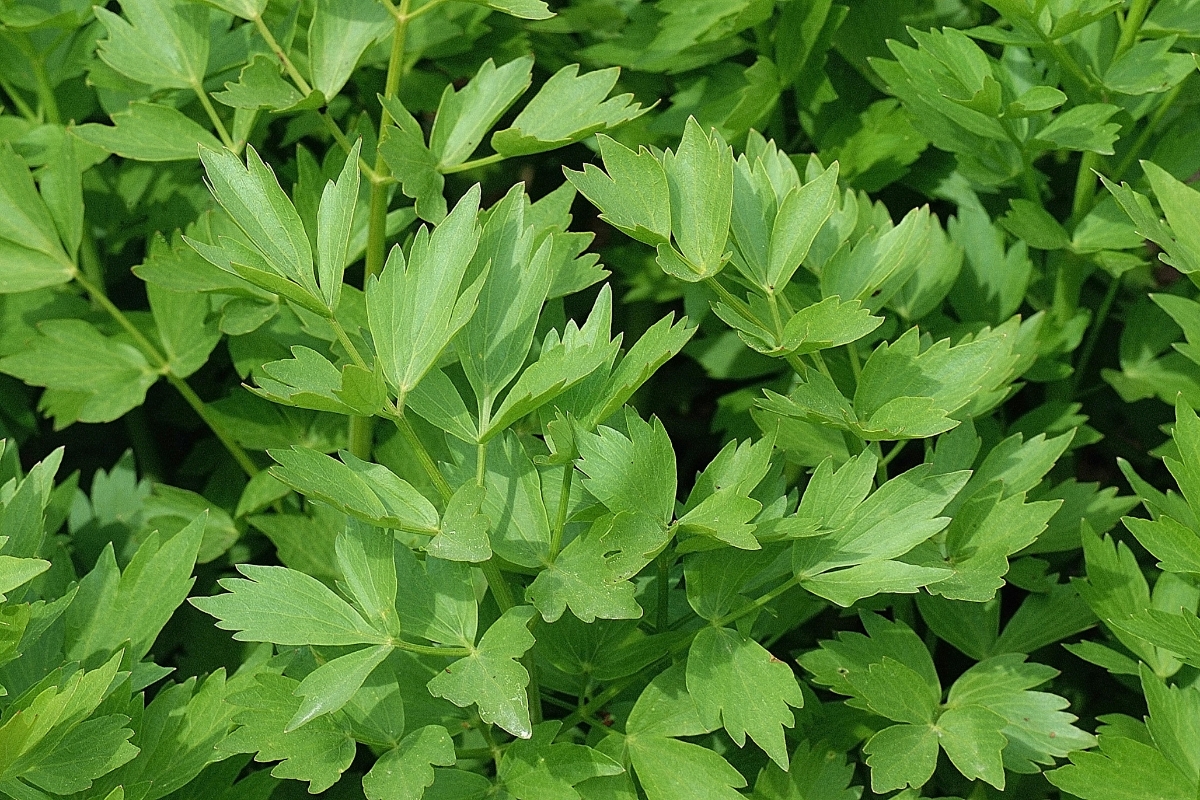
Majoram (Origanum majorana)
In many ancient cultures, marjoram was considered a symbol of happiness and love. It also had a role in some medicinal traditions. Personally, I love it as a culinary herb. Marjoram tastes like a milder version of oregano and is excellent for flavoring tomato dishes, stuffing, poultry, sausages, and wild game.
Majoram is a tender perennial. It will grow as a perennial herb in zones 7 through 9, but in colder zones, you’ll need to grow it as an annual. Majoram can thrive with just 6 hours of sunlight and really benefits from afternoon shade in hot climates. It thrives in fertile, well-drained soil.
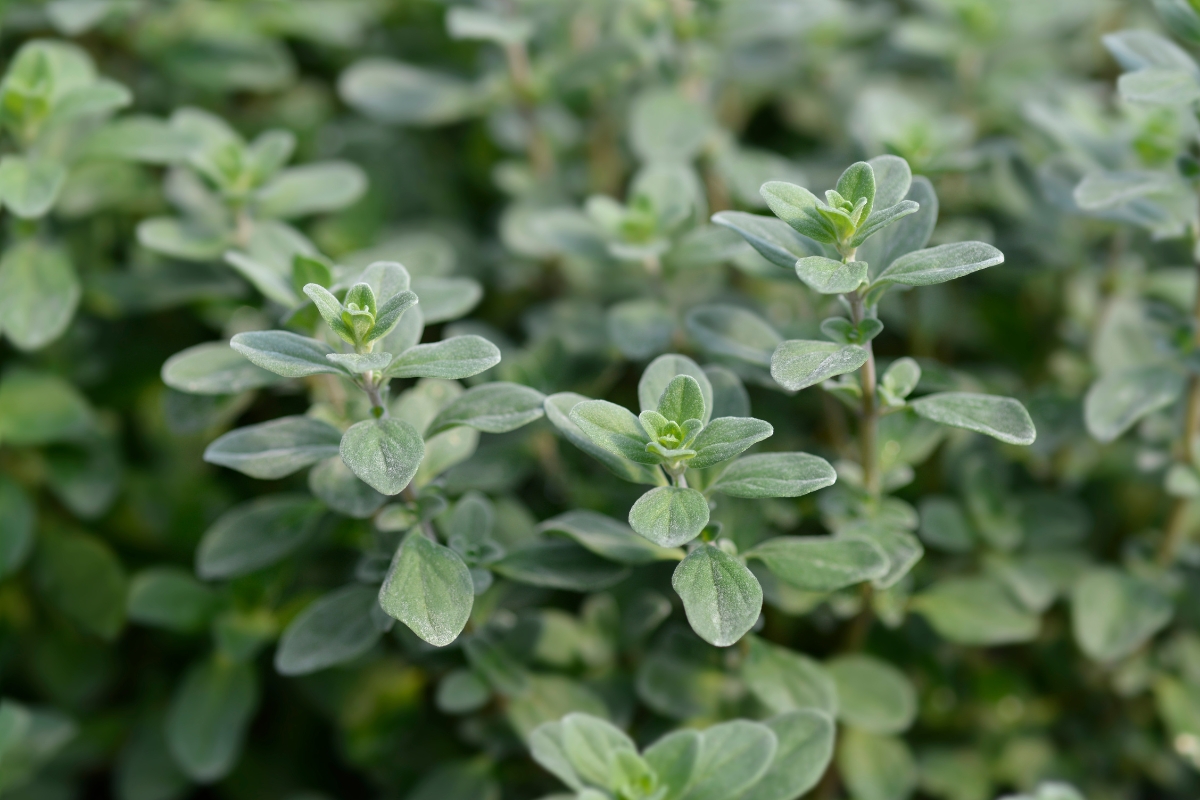
Mint (Mentha spp.)
So many people are afraid to grow mint! I’ve seen tons of reels and posts this year extolling the dangers of this invasive herb. It certainly does spread, but I find it easy enough to control through edging, trimming, and cultivation. However, you can also grow it in pots if you’re worried about its weedy tendency.
If you want to let mint go wild in a shady area, look for native mint. There are several varieties, including American wild mint (Mentha canadensis), which is incredibly widespread.
Mint is as easy to use as it is to grow. I love it for Middle Eastern cuisine and meat dishes like lamb and meatballs. I also love to make my own mint extract, which is handy for mint desserts like mint chocolate bars and grasshopper pie. Dried mint also makes a lovely stomach-soothing tea that’s mild enough that most children will enjoy it with a bit of honey.
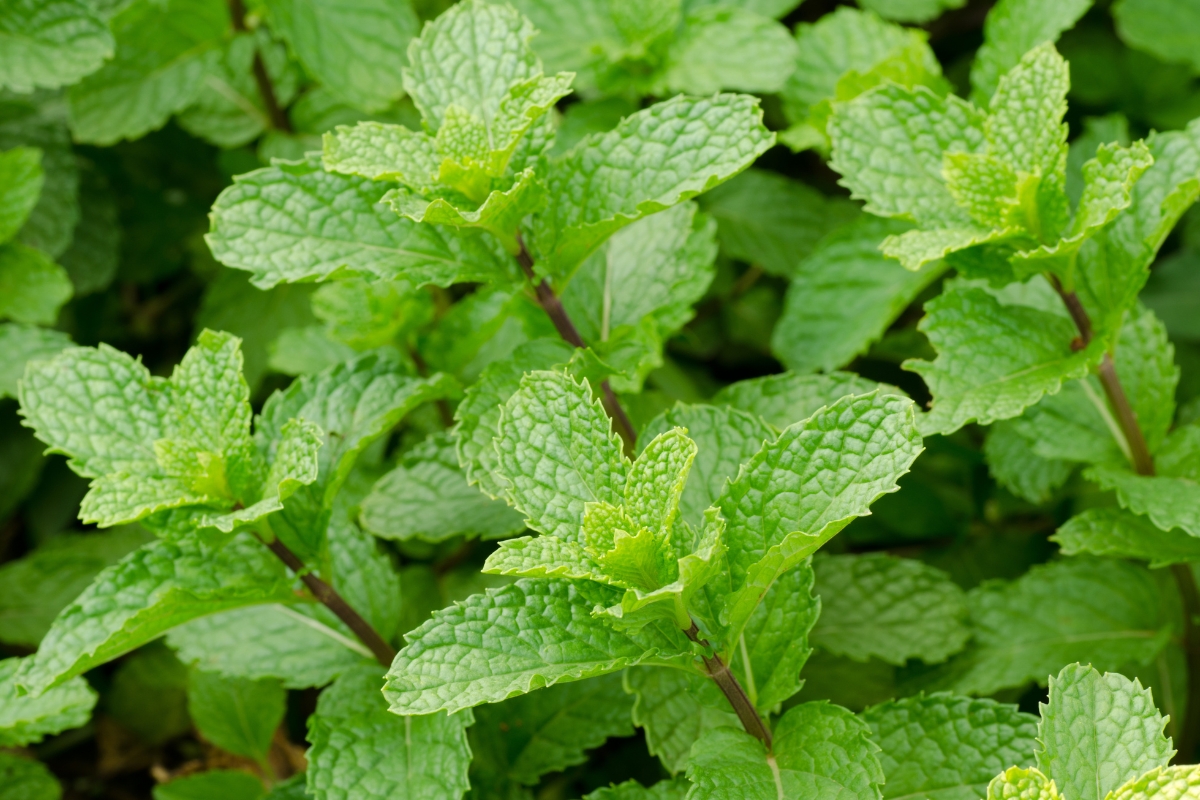
Oregano (Origanum vulgare)
We all know oregano is a must-have herb for Greek and Italian food. Fresh oregano is a great way to add incredible, authentic flavor to pizza, lamb, and sauces. In Greek, “oregano” means “joy of the mountain.” It is also wonderful for Mexican and Cuban dishes like enchilada sauce and pork.
Thankfully, oregano is a fairly easy keeper in the garden. It thrives in partial shade, particularly in hot climates. It’s an easy-going, perennial member of the mint family that will spread in ideal growing conditions. For best results, plant your oregano in bed with well-drained soil.
Pinching off oregano tips is a great way to harvest, which encourages the plant to grow fuller and bushier.
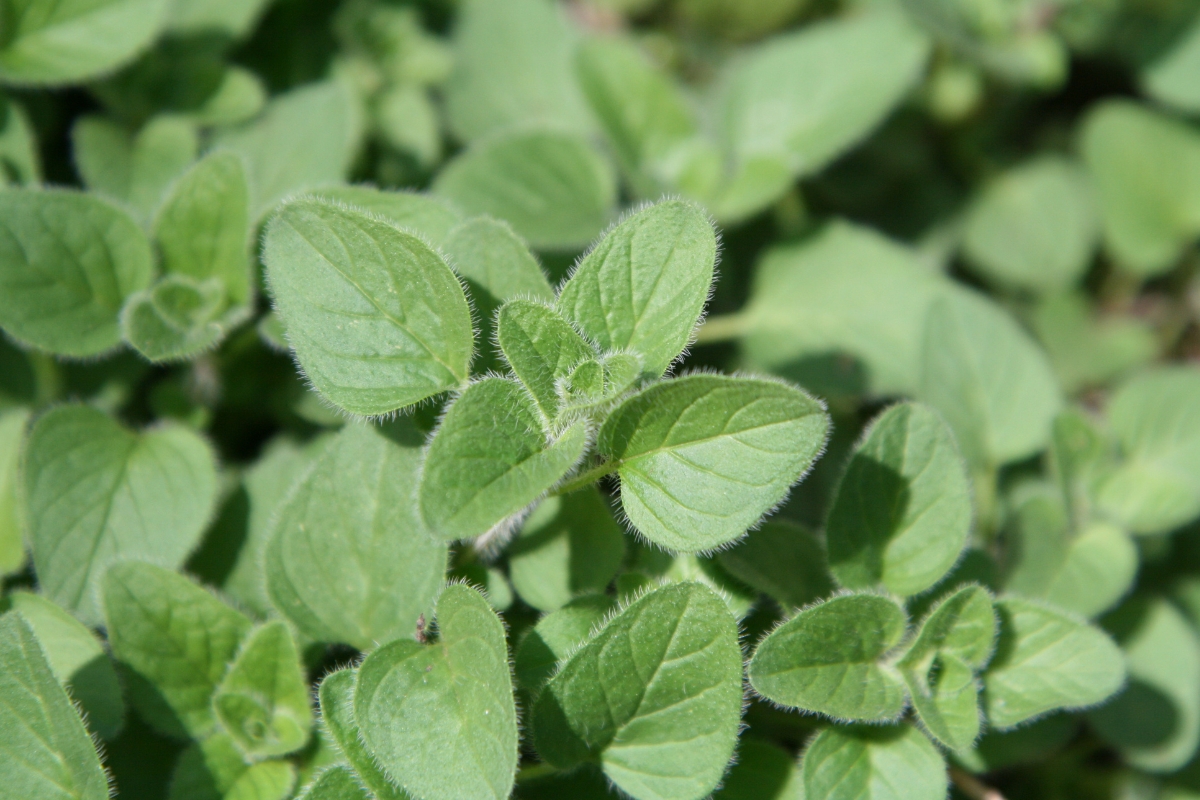
Parsley (Petroselinum crispum)
You’re probably familiar with this herb, especially curled parsley, as the universal garnish. Parsley is so much more than good looks! It’s great for European and Middle Eastern cuisine. It’s also an essential herb in bouquet garni, a French bundle of herbs used to flavor stews, soups, and sauces.
Parsley is a biennial plant, but most gardeners treat it as an annual. It’s an incredibly cold-tolerant herb and one of my favorites to grow in cold frames. It provides fresh flavor and a pop of green long after the warm-season herbs have died back.
Grow your parsley in a bed with moist, well-drained soil. I usually grow parsley from seed, but you’ll need to be patient with it. Parsley sometimes takes four weeks to germinate. You may also have to share a bit of your herb harvest. Some swallowtail butterflies use parsley as a larval host plant. It’s worth giving up a few leaves for the butterflies, though!
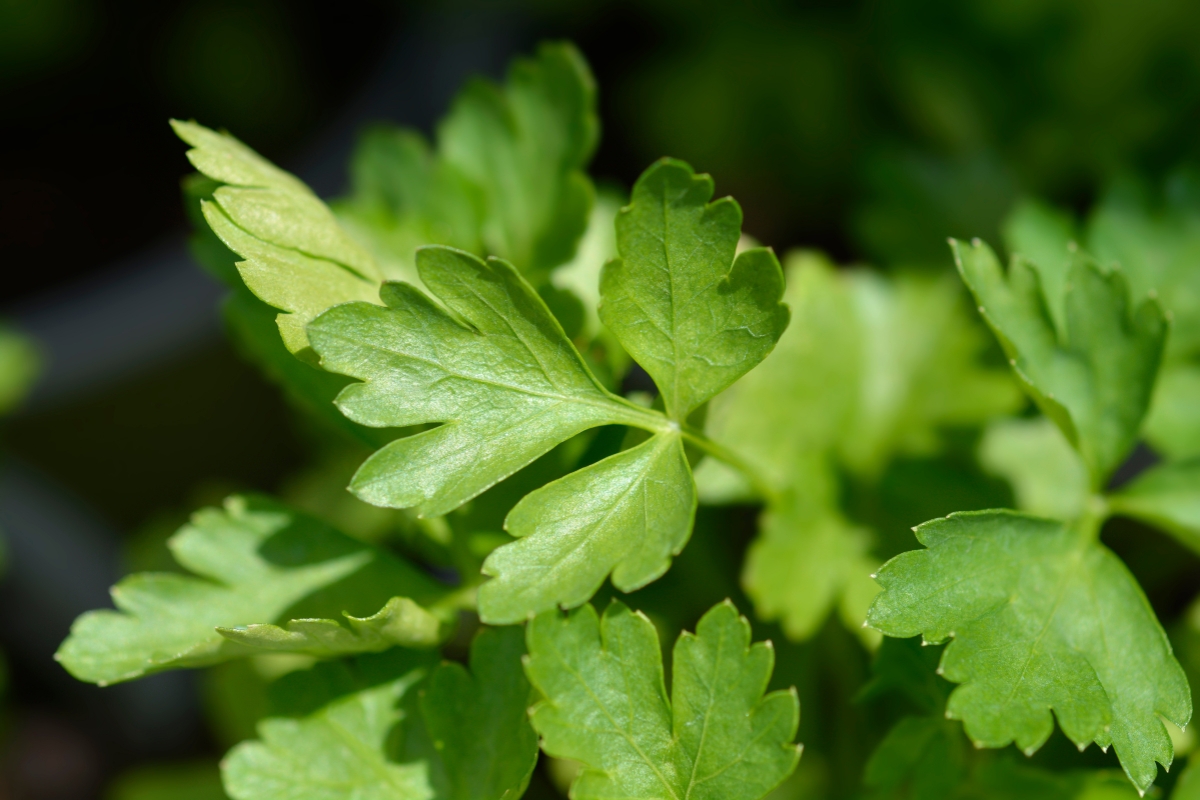
Rosemary (Salvia rosmarinus)
There’s something about fresh rosemary on hand that makes me feel rich. My favorite way to use it is to flavor roast chicken and potatoes. It’s a humble yet incredible meal! We also use rosemary while roasting vegetables and meat on the grill.
Rosemary grows in rich, well-drained soil. It can tolerate as little as four hours of sunlight, though it tends to grow slower in the shade. It’s an excellent option for folks in coastal areas as they tolerate salt.
Unfortunately, rosemary is only perennial in warm climates, thriving in USDA zones 8 through 10. However, if you live in a cooler zone and want to keep your rosemary growing, you can dig it up before your first frost, pot it, and move it indoors for the winter.
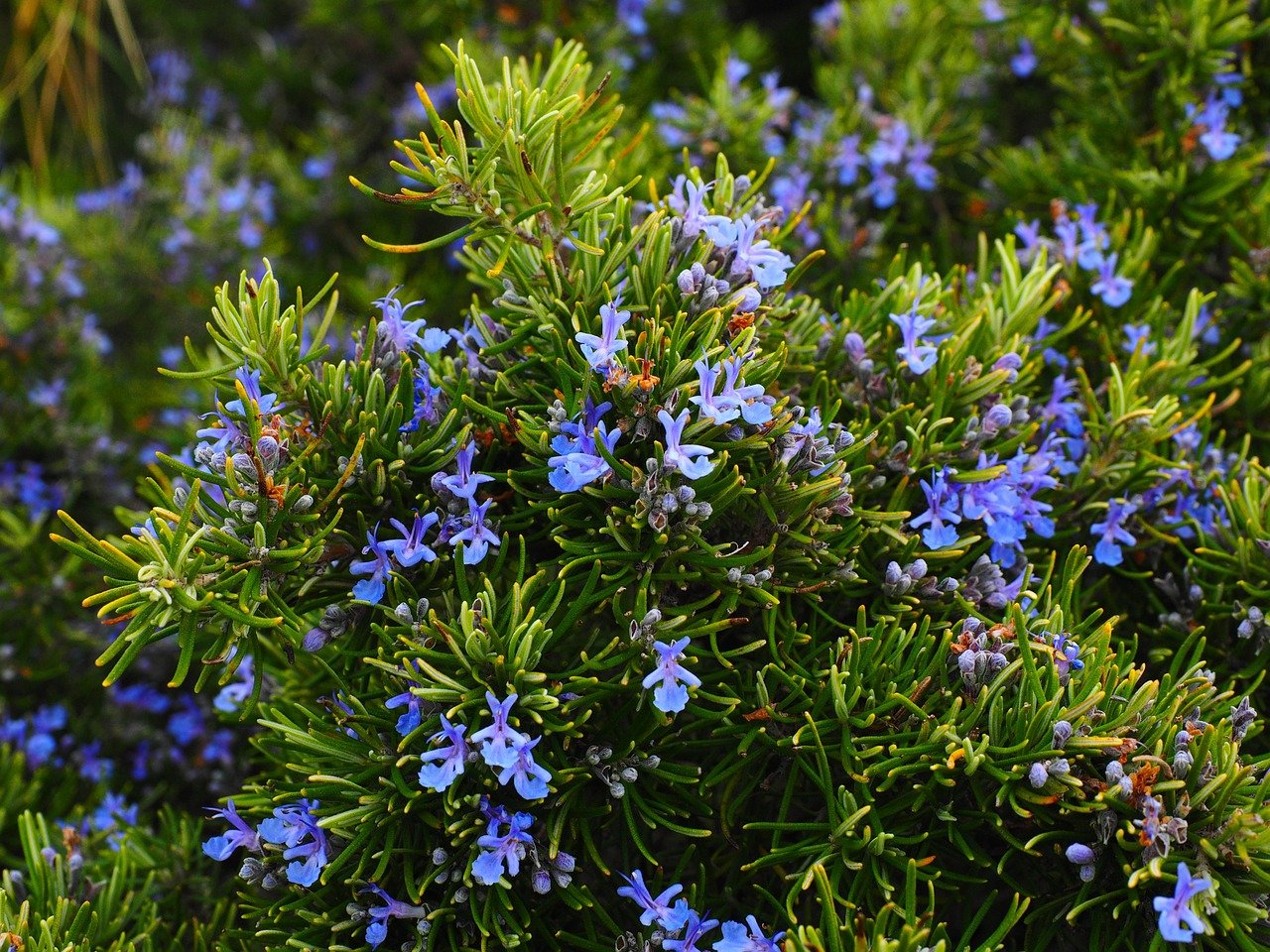
Sage (Salvia officinalis)
Sage may be one of my favorite perennial herbs to look at in the garden. It’s a perennial that forms stunning subshrub type plants up to 2 1/2 feet tall. Sage looks right at home in an herb garden or flower bed, making it a great choice for sneaking past an HOA.
Most sage features gray-green oblong leaves with a pebbly textured surface, but some cultivars have purplish leaves. In the summer, it produces a profusion of flower spikes. Most cultivars have bluish-purple or lavender flowers, but you may find some with white or pink blooms, too.
When selecting a cultivar, look for those that mention being shade tolerant. Some have been specifically bred to tolerate more shade than others. All sage plants will grow best in well-drained soil. They tolerate nutrient soil well and are incredibly drought-tolerant once established.
Sage is a kitchen essential for classic southern gravy, which is poured over chicken and biscuits. It’s also an essential ingredient in Thanksgiving stuffing. Homegrown sage is much more flavorful and is sure to impress the guests.
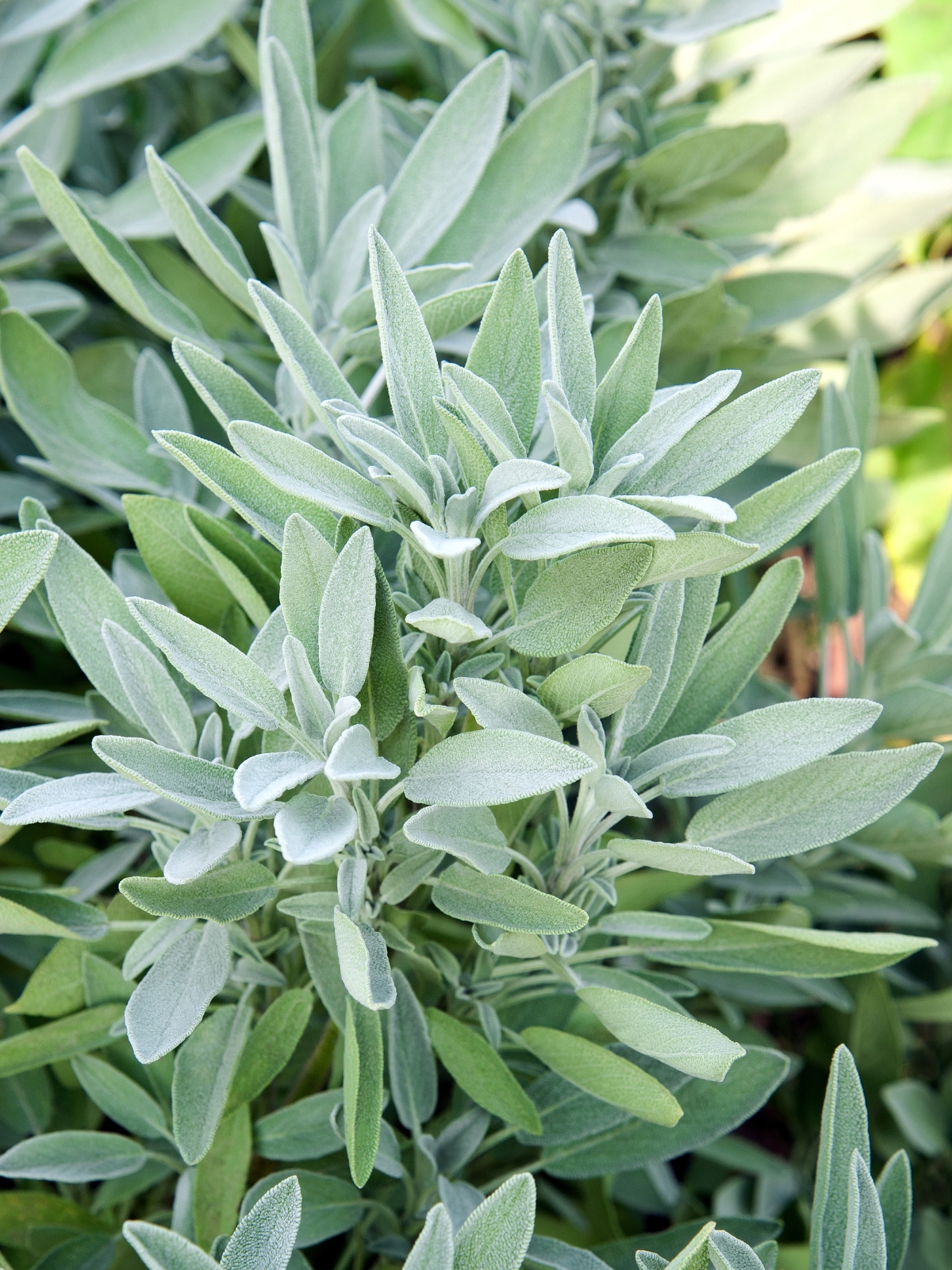
Sorrel (Rumex acetosa)
Long before lemons and other citrus arrived on European shores, the hardy sorrel was adding tangy, lemon-like flavor to sauces and dishes. It looks a bit like spinach and packs a ton of nutrition and flavor into every leaf. I love using sorrel in fresh salads, pesto, and marinades for grilled vegetables and fish.
Sorrel has the added benefit of being easy to grow. This hardy herb thrives in partial shade and cold winters, up to zone 3. It needs well-drained soil to flourish, but in proper conditions will grow and spread so that you can divide it for transplanting the following spring.
This perennial is also among the first crops you’ll be able to harvest in spring. For people of the past, its early appearance made it an essential source of food and medicine.
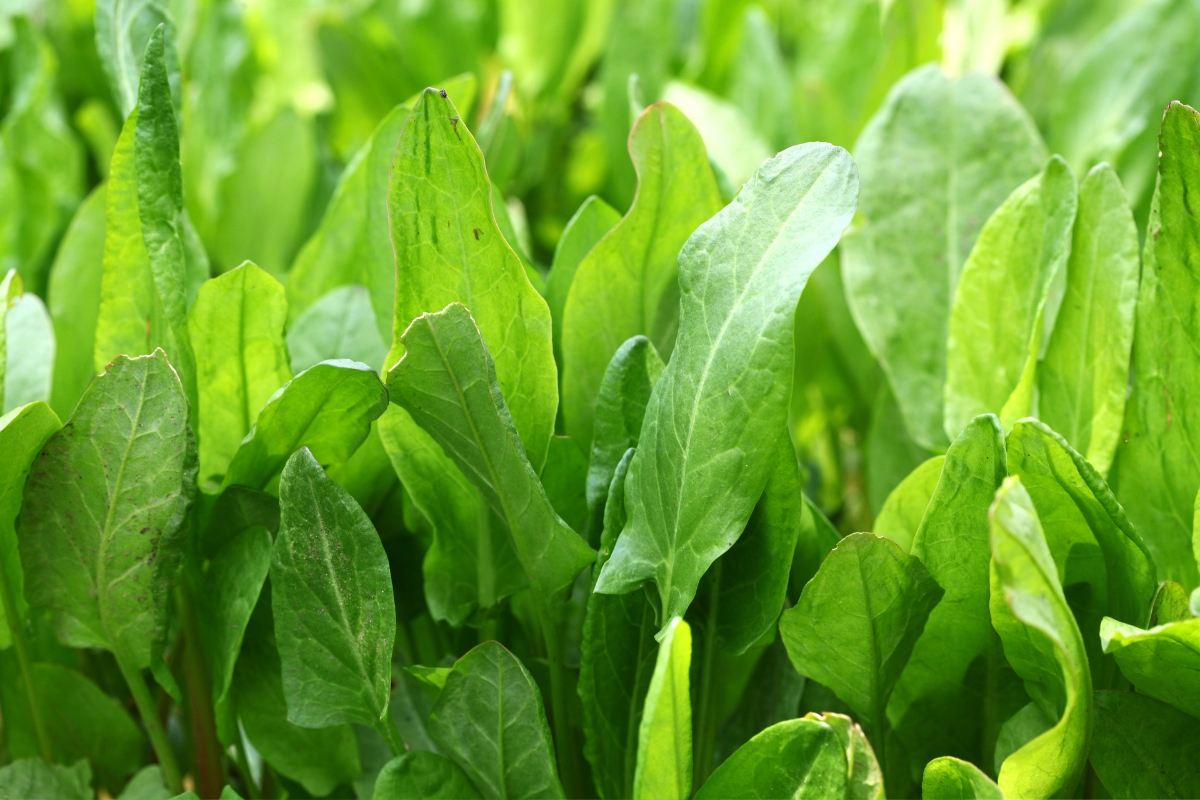
Sweet Cicely (Myrrhis odorata)
Sweet Cicely may be the most shade-tolerant herb on this list. It’s an herbaceous perennial in the celery family that thrives in rich, damp soil in full to partial shade. Its leaves, roots, flowers, and seeds are edible and have a distinct anise or licorice-like smell and flavor.
Personally, I love using sweet Cicely in sweet dishes like fruit crumbles. The roots are excellent candied. Over the years, this herb has seen a multitude of other uses. The roots and leaves have been used as vegetables, especially in soups and stews. They have also been used as a celery substitute, a fragrance for furniture polish, a natural dye, and a medicine.
You can grow sweet Cicely as a perennial in zone 3 through 7. Its delicate fern-like foliage and umbels of tiny white flowers make it a great way to add beauty and production to shady borders and the north sides of buildings.
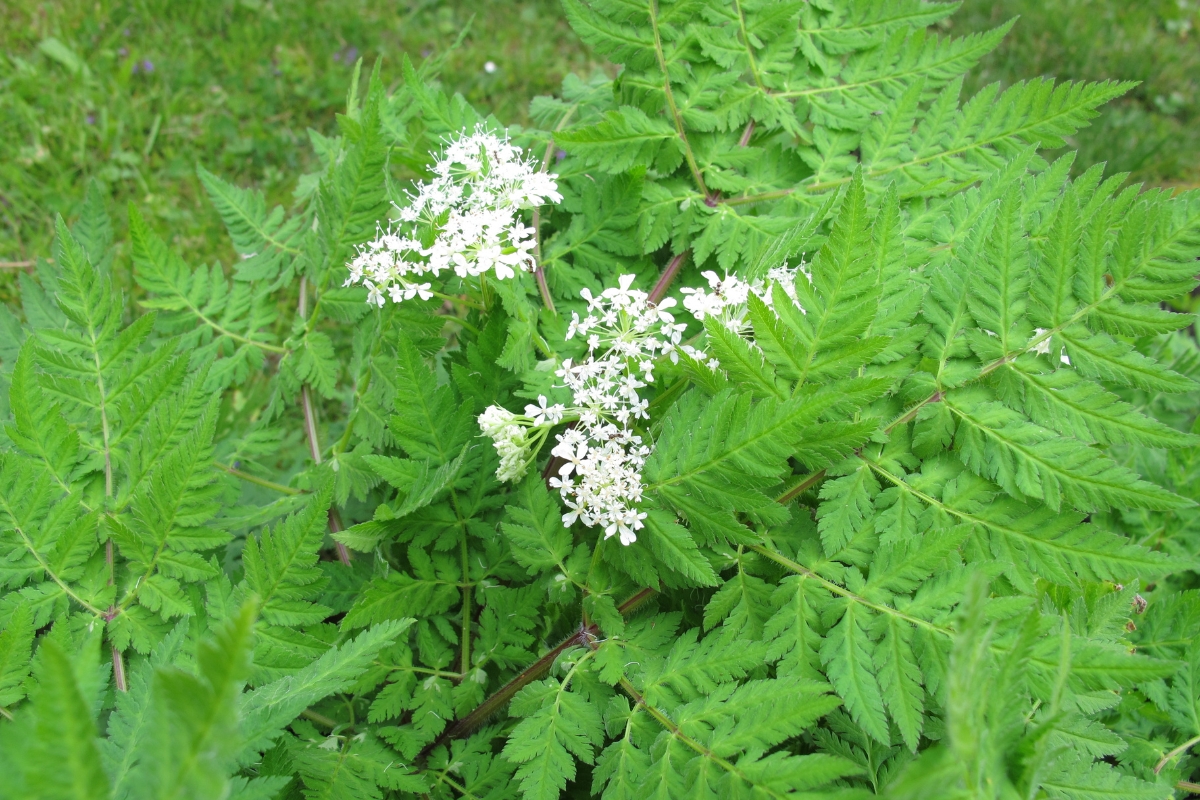
Sweet Woodruff (Galium odoratum)
Sweet woodruff is probably the only member of the cleavers family that people actually plant. While the others are generally considered weedy, Sweet woodruff’s sweet scent has earned it an ardent following. In some European countries, it’s used to flavor ice cream, sherbet powder, beer, jellies, brandy, juices, tea, vanilla substitute, and May wine.
However, some mouse and rat studies have found that coumarin, the chemical in sweet woodruff that gives it its fragrance, may be harmful. Many countries have prohibited or regulated its use, though it is still used in the countryside and in small quantities in liquor and beer marketed to adults.
Sweet woodruff needs some shade to thrive. Grow it on the shady side of a house or in beds beneath trees in your yard. It prefers acidic, moist, but well-drained soil.
Sweet woodruff is a perennial in zones 4 through 8. In ideal growing conditions, it spreads through seed and creeping rhizomes. Some gardeners find it a bit weedy and aggressive.
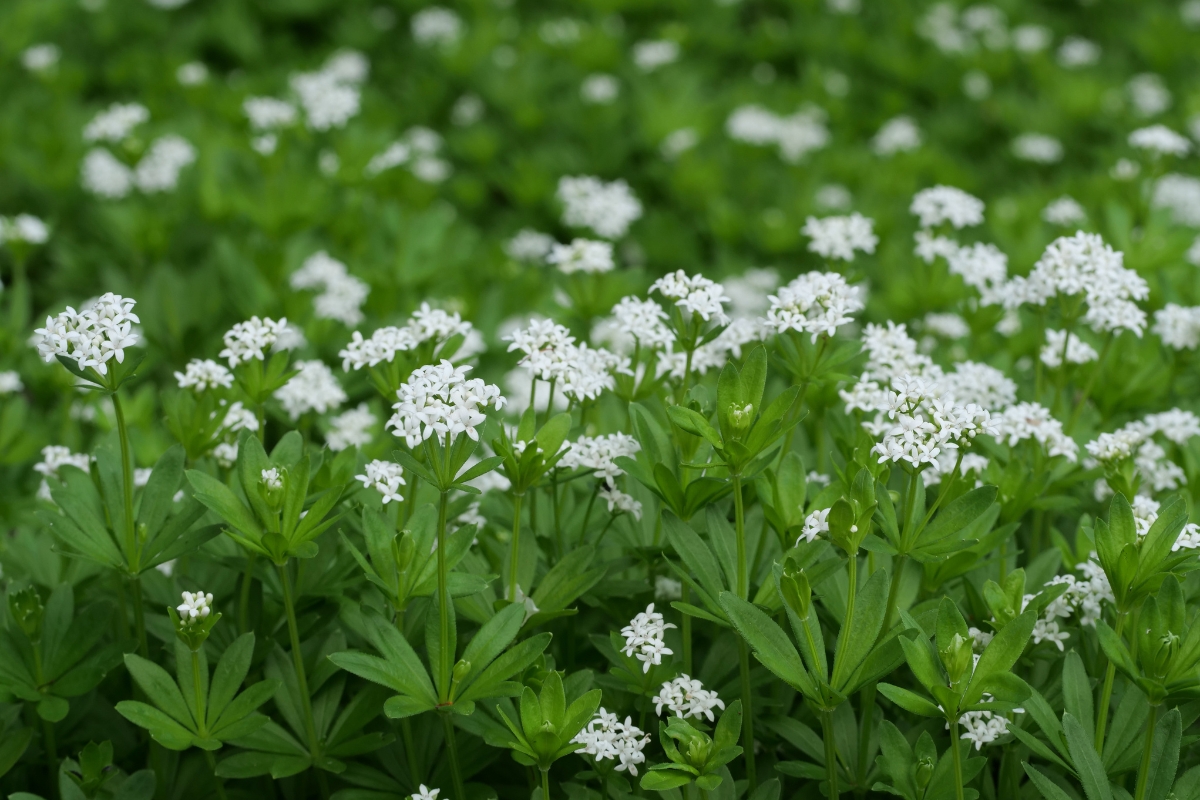
Tarragon (Artemisia dracunculus)
In France, tarragon is known as “the king of herbs.” It is common in several French classics, like Béarnaise sauce and fines herbes. Like the French, I love using it in sauces, dressings, and fish and chicken dishes.
Tarrgon is a delicate herb with volatile oils that give it its springy, slightly licorice-like flavor. The difference between fresh and dried tarragon is astounding, so I find it worthwhile to include in the garden. Thankfully, it’s fairly easy to grow, even if your garden is a tad shady.
There are a few different types of tarragon, but French tarragon is generally considered the best for culinary use. Tarragon is a perennial in zones four and warmer, though it benefits from some winter protection, particularly in areas with intense winds.
French tarragon must be started from cuttings or transplants rather than seed. Plant your tarragon somewhere with good drainage, like a raised bed. Adding compost before planting can improve soil structure and drainage.
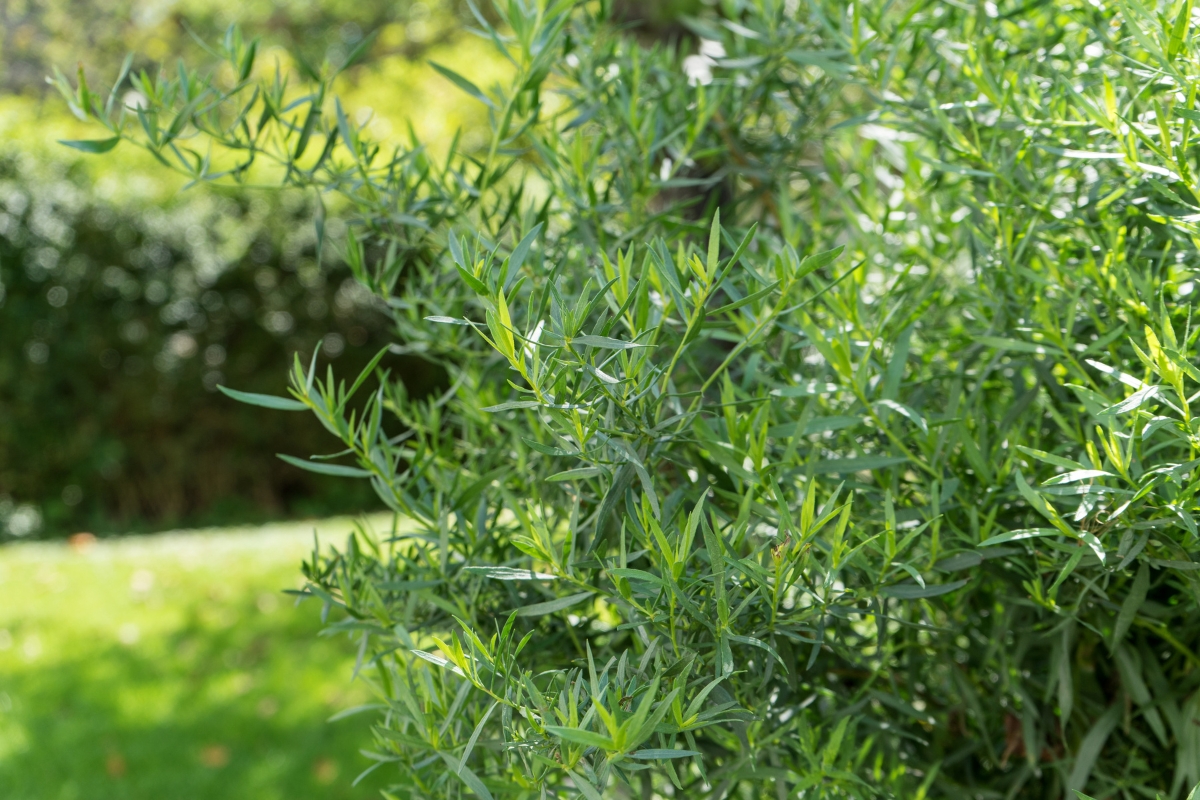
Thyme (Thymus spp.)
Thyme is a staple of French seasoning. It is usually found in bouquet garni and herbes de Provence. I love using it for roasted poultry and vegetables, chicken pot pie, and mushrooms. It may seem a little odd, but it also goes well with some desserts, like roasted pears and lemon sorbet.
Thyme’s beauty and incredible fragrance have also earned it a place in many landscapes, rock gardens, and ornamental flower beds. The creeping varieties of thyme make excellent, useful ground covers.
Its fragrance has been beloved throughout the years. The ancient Egyptians used thyme for embalming, the Romans used it to purify rooms, and the ancient Greeks used it as temple incense.
Before planting thyme, do your research on varieties. There are many thyme species and cultivars, each with its own unique flavors, fragrance, and growing habits. Common or English thyme (Thymus vulgaris) is usually the species used as a kitchen herb. Thyme will tolerate partial shade, though it may not flower. It is drought tolerant and thrives in well-drained, poor, alkaline soil.
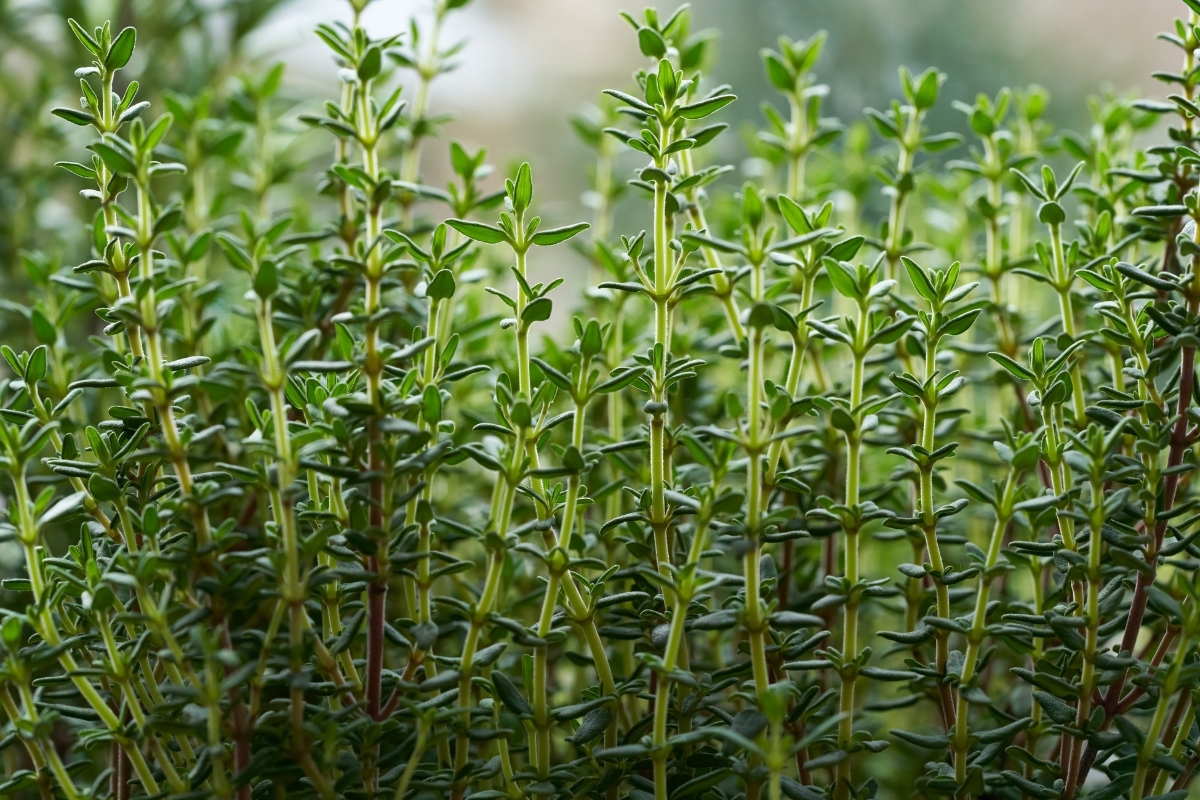
Winter Savory (Satureja montana)
The Ancient Greeks and Romans were using winter savory 2000 years ago! Its spicy, peppery leaves are delicious in sausage, stew, soup, salads, beans, meat and fish dishes. It’s also a helpful medicinal herb.
I love growing winter savory in the garden. It is shade-tolerant and beautiful, perfect for adding a little production to neglected spots of the property. It’s also a wonderful companion plant for beans, helping to deter bean weevils. You can also grow it beneath your rose bushes; some studies have indicated it may reduce mildew.
Winter savory is a shrubby herb with beautiful white, pale lavender, or pink flowers growing up to 16 inches tall. You can grow winter savory from cuttings or seeds. It’s perennial in zones 5 through 11. It’s a tough plant that will grow in dry, sandy soil.
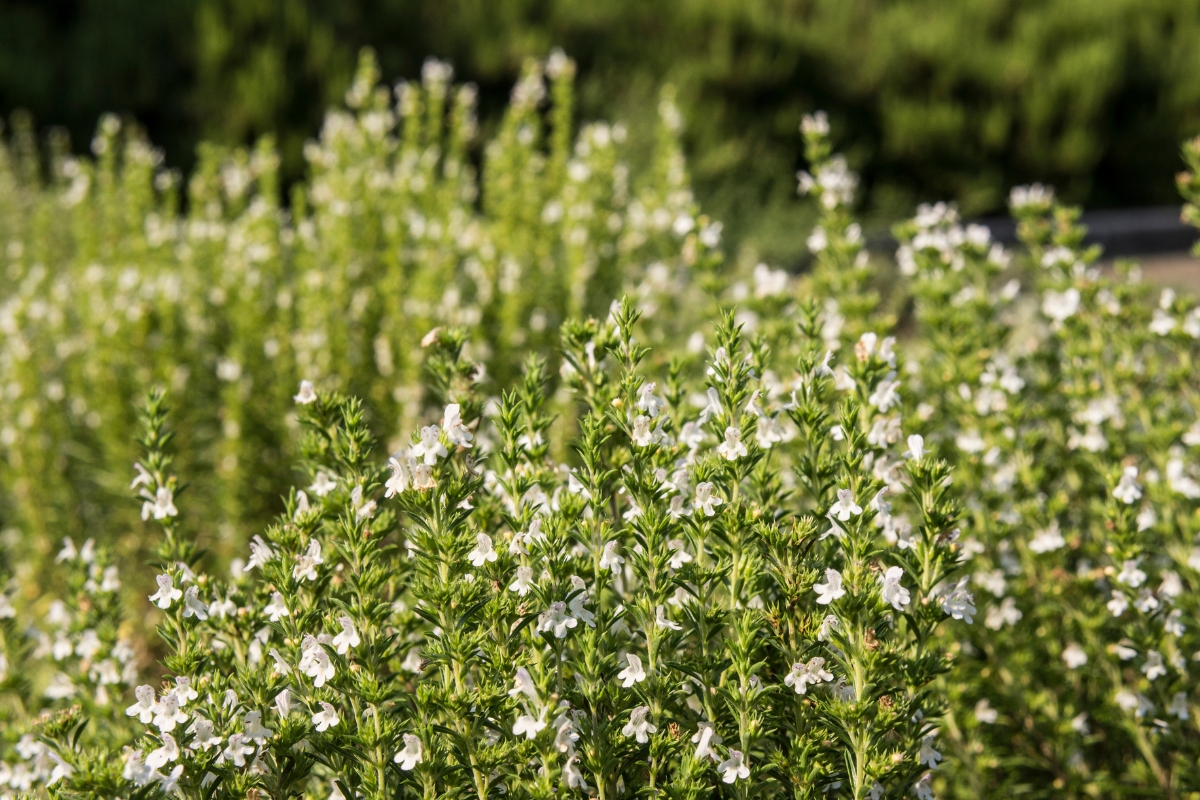
Herb Guides
Interested in more ways to grow and work with herbs? Be sure to check out our other herb guides.
- Drying Herbs at Home
- 8 Ways to Preserve Herbs
- 20 Immune Boosting Herbs (& Mushrooms!)
- Medicinal Herbs to Plant for the Bees
- 20+ Herbal Tincture Recipes (for Homemade Herbal Medicine)
